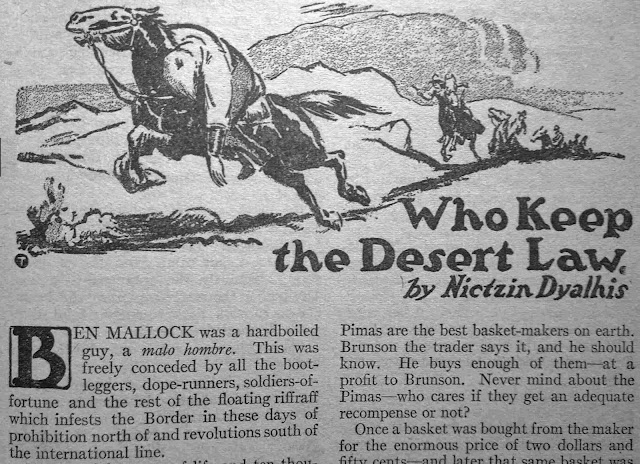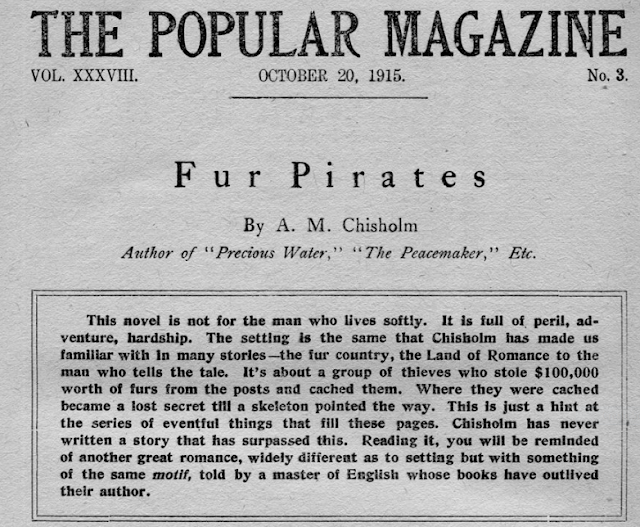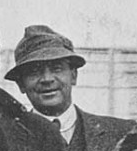[This is an excerpt from the Campfire column in the issue of Adventure magazine dated April 10, 1922. It's about H.D. Couzens - whose novelette, Brethren of the Beach, was being published in expanded form in that issue.]
 |
| H.D Couzens - Brethren of the Beach - Adventure, April 10, 1922 |
HARRY D. COUZENS, whose complete novelette appears in this issue, died in Arizona in May, 1914, after a long, brave fight against tuberculosis. Our reprinting “Brethren of the Beach” in enlarged form is explained in a note at the beginning of the story.
You old-timers will remember him, for his stories were favorites with you. Personally he was a man. If you knew him you liked him and admired him.
The following is from the Arizona Republican of May 20, 1914:
H. D. COUZENS was for many years one of the most prominent residents of Honolulu, T. H., where he held the position of chief deputy in the internal revenue service of the United States, and in that capacity gained distinction for efficiency in the performance of the duties of an office which, in that territory where smuggling and other illicit practises were unusually prevalent, required the exercise of much hardihood and courage.
During his residence in Honolulu and later in Los Angeles and New York, Mr. Couzens worked assiduously at writing and painting, in both of which arts he gained a wide reputation. Although his pictures, depicting different phases of the tribal life of the natives of Hawaii and of other parts of the world, brought him repeatedly into favorable prominence in the United States, his greatest reputation was earned as a writer of adventure stories full of the tang the South Seas and accurately descriptive of the islanders and of the varied types of white men who live among them. His knowledge of these people was obtained through personal association during his living and voyaging among the myriad islands of the southern seas and his writing was correspondingly true to life.
HE WAS, I think, the subject of the first of those informal talks that grew into our “Camp—Fire” department—when only the page facing the opening page of an issue was used for the purpose.
In those first days the author did not talk direct to readers but sent me the material from which I made my little “talk.”
THE following is his letter to me, giving me the information I used in that first talk:
Born Virginia. Ancestors, father’s side, long line of sea-captains back to Matthew Couzens, original settler at Newport, who was captain of British privateer: Hence roving disposition, I suppose. Educated and intended for engineer. Left New York in 1886 for Honolulu where I lived 4 years, returning in 1890 to New York intending to finish my engineering course and continue as the successor of my grandfather, Matthew K. Couzens, a civil engineer of Yonkers, N. Y., but found I was too good a draftsman. Had always done drawing and painting after a fashion but decided to take up art seriously as a career. I studied at the Art League and the old William M. Chase school on 23rd Street and later went to Paris where I studied in the Julian school and in the studios of Carolus Duran and I. L. Gérôme. As I had no funds for this, I was obliged to earn every cent as I went along and my years of study were a period of some privation upon which I do not look back with much pleasure. I have a house in Paris, or rather the little suburb of Renard, which I haven’t seen for fifteen years.
IN 1899 I left New York for Honolulu and lived there till 1907. In 1900, when the islands were formally annexed to the U. S., I was appointed Chief Deputy in the Internal Revenue service and held that in Honolulu till 1906. From 1907 till 1909 I lived in San Francisco when, by special request I accepted the appointment of Chief Deputy of Internal Revenue in Los Angeles. California had been divided into two official districts and my services were in demand as an expert to help them establish the new Southern District. I accepted a 60-day appointment but at the end of that period was asked to officiate for 60 days longer and did so. I came to New York in 1910, returning to Log Angeles in January, 1911, to settle some business matters.
SO MUCH for bare facts. These as they stand are not particularly interesting and you can utilize them as you see fit. The real that you want I’ll try to string along at random. For instance:
I have cruised in the South Seas, have chummed with traders, blackbirders, beach-combers, remittance-men and sailors. Kipling once said that if one lived at Port Said long enough he would meet everybody in the world. I think this is truer of Honolulu than it is of Port Said—at least you'll meet them there in less time. I met Robert Louis Stevenson in King Kalakaua’s stand at the old racetrack, and I’ve sat with Jack London on the lanai of the Seaside Hotel and heard him roast his critics by the hour. I have gone back and forth across the Pacific on Army transports and found old school mates in captain’s uniform seated opposite me at mess. I think I have as large a nodding or speaking acquaintance as any man in the world.
This may be trite enough and I realize that you want things can use to advantage. It is harder, I assure you, to write this sort of thing than episodic fiction. I may say that my best friend in Honolulu was Captain Albert H. Otis, who was captain of the yacht “Casco” when Stevenson took his celebrated cruise, and who is the original of “Captain Nares” in “The Wrecker”. He, dear man, has been the unconscious original of more than one of my fictitious sailor-men.
I HAVE slept out in the hills in the quest for moonshiners, and being entirely an out-of-door man by instinct and inclination have ridden horses of all tempers and breeds, sailed boats of all rigs, used firearms of all descriptions since I was too young to remember. Revolver-shooting is a hobby and I have several trophies for revolver and shot-gun work. Like Stevenson, I too have slept out in Portsmouth Square under the sky; and, like him too, all my life I have tried to write and seen my most ambitious efforts (essays, etc.) overlooked. Here the resemblance probably ceases.
I HAVE always had the inclination for literature and have been actually writing for publication since 1894, when a story of mine which appeared in Outing fired me with the ambition to peg away and make good in this way but it was later, when I was in the Revenue Service in Honolulu, that I began to tackle the real stuff. I used to go down to the office in the old Palace and plug away on my stories (sometimes all night long) and many of my things that are appearing now are the direct result of that patient industry. Some of it I sold, but I hoarded the rest against the great idea of coming East to the proper market for it and making good.
I was actually on my way to New York with this idea when I reached San Francisco in 1907. Then I reasoned with myself something after this fashion: I knew San Francisco, after a fashion, but. I knew no one there who be of the slightest use or help to me, whereas in New York I had friends and influence. Why, then, would it not be a good idea to “try it on the dog?” In other words, see if I could make good there first. I set myself a. mark. It was to sell Sunset Magazine a. good story (one that I approved of myself), illustrated by myself and then I would keep on my way East.
Well, I did it. I sold them a good many other things, cover pictures, illustrations, etc., and did considerable work for the art department of the Southern Pacific. I turned out stuff for various publications including the Western Field, the Newsletter and Crocker’s monthly and had various interests with engraving firms and lithographers that kept me pretty busy. I felt in the beginning that I was taking a sporting chance. That was my reason for stopping there in the first place, but as soon as they published “On Mokapu Beach” with my illustrations I packed my trunks.
Then came the appointment to the District of Southern California and I spent the following year there looking out for the interests of Uncle Sam, shooting quail and ducks and catching rainbow trout-altogether a busy and interesting year.
ITHINK this is about all. I know you don’t want anything of the personal adventure stuff in this else could branch into various flights. Perhaps you can find enough to answer your purpose in what I have written here. You might dwell on the fact that the South Seas and its people and what men do with schooners have been things of particular interest to me and I have made an effort to set some of them down in an interesting way. I’m still trying of course and I trust that Billy Englehart and I will have many a wild cruise together. The company of that celebrated ruffian is meat and drink to me, as Billy Bones says.
Note: Brethren of the Beach can be found in the outstanding collection from Black Dog Books, The Best of Adventure, 1910-1912.




